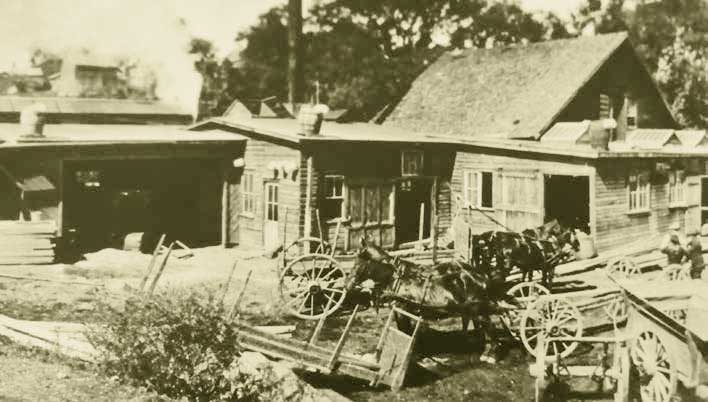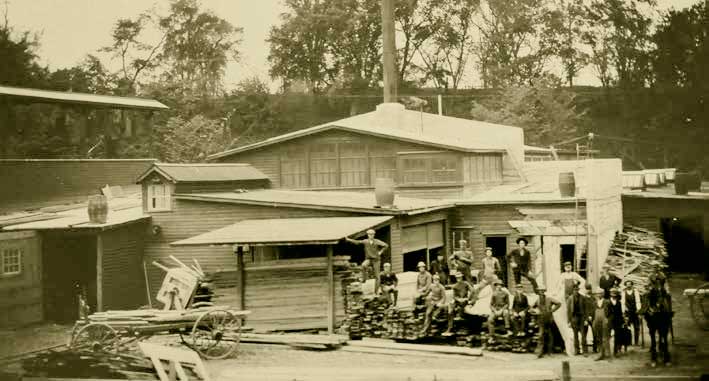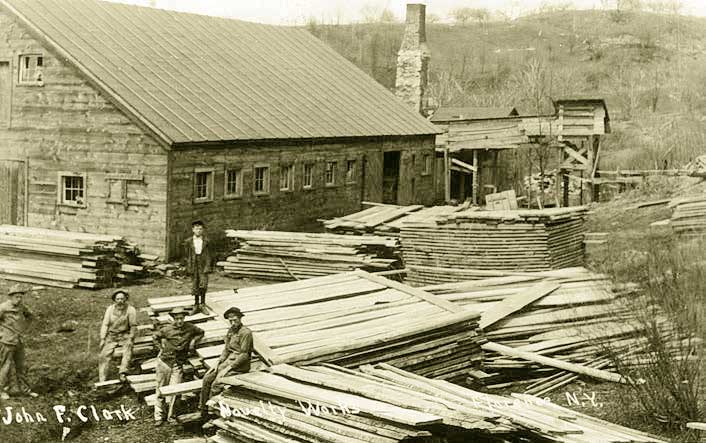
A. Mason & Sons of Peru, New York
By Neal Burdick
Sawmills were essential to America’s economic development and the building of communities. They provided work for mill hands, and in some companies, steady work and pensions. The sawmills allowed waste products to be used for other purposes, and supplied lumber not only to New York but to regions as far-flung as the South and the Midwest.
Neal Burdick is the grandson of Charles Mason, A. Mason & Sons’ draftsman who died during the flu pandemic of 1918-19, some 31 years before Burdick was born. He has childhood memories of the mill’s sawdust aroma and its five o’clock steam whistle signaling the end of the workday. The company no longer exists, having succumbed to pressure from “big boys” in the 1970s.
– William J. O’Hern
Soon after the Civil War, Albert Mason started a lumber milling operation on the Little Ausable River where it ran through the Clinton County village of Peru, New York, in the shadow of Huckleberry Mountain and the rest of the northeastern Adirondack foothills. His son George grew to maturity and joined the business, then George’s brother Nate, then Charles, and eventually Will, Ed, and Herb, the six strapping young men constituting the “& Sons” of the company. Charles was my maternal grandfather, but I never knew him; along with millions worldwide, he died in the great influenza pandemic of 1918, when my mother was just six years old. Each of the boys worked his way up through the ranks, and each was missing at least one finger, undeniable evidence that although he was part of “management” – the treasurer or a draftsman perhaps, he had nevertheless been expected to learn how to use the powerful circular saws, planers, lathes and other equipment necessary to a milling operation.

The A. Mason & Sons mill and shop about 1890. The horse-drawn cart in the right foreground carried sawdust from the mill to the shop’s boiler room for fuel. The barrels on the roof held water for fire suppression. The Mason complex included a blacksmith shop, far left, while the buildings in the left background were in the center of Peru village, uphill from the shallow valley of the Litte Ausable River.
Mason’s mill produced lumber for houses, barns, stores and so on, while an adjoining shop turned out woodwork, such as newel posts, stair railings, windows, doors, and residential trim. A. Mason & Sons’ craftsmanship can still be seen in countless houses throughout northeast New York State, but perhaps most noticeably in the woodwork of the Valcour Island lighthouse, now an historic site on Lake Champlain.
Theirs was an integrated operation; that is, they produced their own timber rather than buying it from jobbers. The Masons owned woodlots in the vicinity of Onchiota in southern Franklin County, from which they harvested the trees (mostly white pine, but some hardwoods for door sills and the like) that they then fashioned into either retail lumber or construction components. How they transported the logs the fifty-some-odd miles to the Peru mill I do not know; the lots were in the Saranac River watershed, which was too shallow to permit the iconic softwood log drives of Hudson River or Black River renown, and besides, the mill was in a different watershed. I suspect they shipped the raw material by rail to Plattsburgh via the Delaware & Hudson’s Chateaugay Branch, which despite its name ran between Saranac Lake and Plattsburgh, passing through Onchiota, and thence from Plattsburgh on the D&H’s Ausable Branch, which featured a siding for the mill on its way to its terminus in Ausable Forks.

The A. Mason & Sons mill and shop about 1910. Among the 20 workers pictured may be founder Albert Mason and some of his six sons. Mason’s also employed workers at its woodlots in Onchiota. The barrels on the roof held water for fire suppression. Below: As for those days gone by, a snapshot of a scene frozen in time is all that we have.
The Masons stored and seasoned their logs in an impoundment of the Little Ausable behind a low dam a few yards upstream from the mill. I remember the pond from my boyhood days of visiting my grandmother’s house, built and outfitted by A. Mason & Sons, just a few rods farther upstream: Clogged with logs, redolent of wet pine, soaked bark lying along the banks, and hordes of frogs who offered a free symphony chorus on summer evenings.

I also remember the stench of rotting wood scraps, other fibrous plant matter, and mud; these were the days before water pollution was of major concern, and clean water legislation was still a few years in the offing. Even the youngest of my five great-uncles were deceased by the time that all came along. I’ve often wondered what they would have said about environmental regulations, or for that matter what they thought of the Adirondack Forest Preserve and State Park legislation of 1885 and 1892 respectively. The company was in full swing then; did those steps hamper their operation and injure its profitability? The park law and the 1894 “forever wild” amendment to the state constitution were put in place in part because loggers were lax about recognizing or obeying the restrictions established by creation of the Forest Preserve; were my greatgrandfather, grandfather and great-uncles among the offenders, or did they foresee the value of forest conservation? By the time I was old enough to recognize this important question, they were no longer alive for me to ask.
Those regulations must not have hurt too much; the business thrived through the early years of the 20th century, and the Mason men built the finest homes in the village for themselves and their families. What did hurt was the Great Depression of the 1930s. In economic hard times, home-builders gave up luxuries like ornate pillars and balustrades. But the Masons refused to lay anyone off; in a small town where everyone knew everyone else and they were the largest single employer, they were determined not to put a breadwinner out of a job. Better to do with less themselves than force someone who’d been a faithful and reliable worker for years to do without. The men, mostly Irish and French Canadians, returned that loyalty by staying on, even if they had to make do with reduced wages.
After World War II came economic recovery, rapid growth, and a housing boom, and business throttled up again. The Masons, now down to three of the six sons of Albert, plus some of their children – third generation in the family business – expanded with a retail lumber yard in Plattsburgh. But competition from the “big boys” like Weyerhauser and 84 Lumber, along with foreign interests, proved increasingly hard to overcome. They branched out into wholesale and retail hardware and building supplies, but the Big Box competition was overwhelming there, too. Truth be told, lack of interest on the part of the third generation also played a part.
In the mid-1970s, after more than 100 years in operation, A. Mason & Sons, like lots of “Mom and Pop” (and all the kids) operations all over the Adirondacks and indeed the nation, folded. The mill closed down, and both it and the lumber yard in Plattsburgh eventually became the sites of low-income subsidized housing – a touch of irony, since the Masons had made home-building components for so long. The dam was breached, and the Little Ausable returned to the quiet and sweet-smelling stream it had once been. A small plaque mounted on a stone indicates the site of the mill, and the family name remains in perpetuity here and there in Peru, as on the facade of the Mason Memorial Library, which the family donated to their community.
One of my favorite memories of Mason’s mill is the sound of the mill’s shrill steam whistle signaling, for all the town to hear, the end of each workday. That whistle has been silenced for many years now, but I still hear it in reveries of my childhood, of an Adirondack way of life now mostly an echo across time.